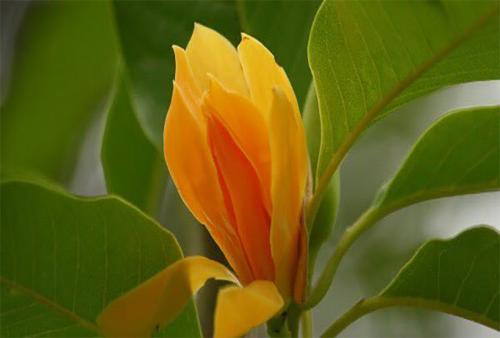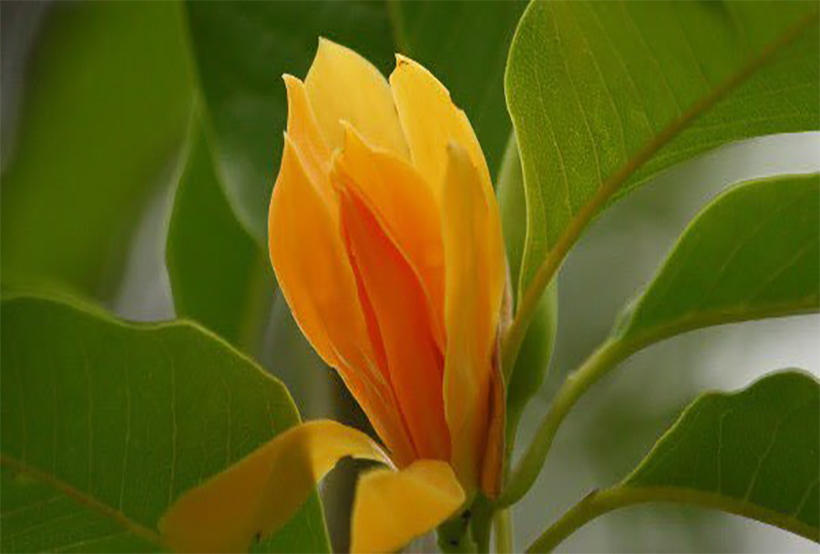Currently being exhibited in the pavilion of regalia, royal decorations and coins is a national treasure which is a particulary interesting and rarely seen object. This object comprises of long-petalled flowers threaded together as short strings (uba) which are lined up to form a round circle. It is made of valuable metals, namely gold and silver and this treasurous object is called gold champak flowers and silver champak flowers. The objects are hung to decorate the ceiling and mandapa in the royal shower hall during the coronation ceremony and also hung on the nine-tiered umbrella. The use of the objects are closely related to royal ceremonies held within the court which might imply some beliefs according to ancient tradition. However, this observation has never been documented.
The Origin and Meaning of the Name Champak
Champak is a kind of flower with which the royal court of Siam has long been familiar. Champak are an inflorescence flower (a flower cluster) that come in a yellow-orange colour and are slightly bigger than white champak. The petals are long. One flower consists of 12-14 pedicles and petals in total with the petals on the outside resembling the shape of a reversed spear, the tip of which are very sharp. The inner petals are shorter and narrower in size than those on the outside.
The origin of the name of champak is assumed to be from India. This is because champak’s scientific name ends with champaca which is what the flower is called in India. It is also called champa in Hindi and champaca in sanskrit; the flower’s scientific name must have derived from sanskrit writing and it is likely that the name of champak originated in ancient India.
According to the dictionary of the royal institute of Thailand, five definitions are given to the word champa in theThai language;
1. The name of a large tree, with yellow-orange flowers. The petals of the flower are large and long, and are many in number. The flowers have a nice-smelling scent. In the local language of Isaan region, it refers to frangipani flowers.
2. An accessory on a chula kite; its shape resembles petals of a champak flower.
3. A badge which resembles the shape of champak flowers. It is attached to a spindle inside an antique chinese lock, used to prevent the keys from falling off.
4. A piece of bamboo stick, the end of which is made into 4-5 sections vertically. The sections are made wider with another piece of wood, making the stick resemble a champak flower in its form. It is used to obtain fruit from tall trees.
5. A wooden accessory to hold a door sill and a door frame together, used in buildings, Buddhist chapels or halls which are built according to traditional Thai architecture. It is a square cylinder, the front of which is decorated and crafted into a floral outline or a four-petalled flower, which is called dok pra chum yam.
It is seen from the definitions above that the word champa has been adopted to refer to objects, the form of which resemble a champak flower. This shows that champak has been a well-known and popular flower among Thai people since early times. The name champa flower is probably related to the frangipani, Lao champak, Khmer champak and Kamboja in Indonesian. Lao people often refer to frangipani (lan thom or leelawadee in Thai) as a champa flower, which they regard as their national flower and having auspicious meaning. This shows that the belief from India regarding champak flowers has spread very widely throughout Southeast Asia.
The Belief Regarding Champak Flowers
In the ancient times, champak flowers were believed to be auspicious, which is a result of the influence from India. It is assumed that Indian people must have brought this belief into Suvarnabhumi country while they were conducting trades with the local people while also passing along some of their civilisation, culture and religion. Religious beliefs which were being introduced to the natives were only known among the nobles or those in the ruling class.
According to Hinduism, champa trees are regarded as sacred in same way as the bodhi tree or banyan tree. They are usually planted in an area of worshipping and the branches of the tree are never to be cut. Flowers are used as an offering to the deities and spirits. According to Mahayana Buddhism, it is believed that the champak tree is the tree under which a future Buddha will attain Enlightenment. There is a document on the future of Buddhas which mentions that a future Buddha will be awakened under a Champak tree; 33rd book of Sutta Pitaka, 25th Khuddaka Nikaya. According to Buddhavamsa text; the 17th Buddha - Atthadassi Buddha, after 8 months of practising, is said to have attained enlightenment around a wild champak tree. For these reasons, the champak flower has become an auspicious and sacred flower to both Hinduism and Buddhism.
Additionally, Thai people in the old days usually wore champak flowers over their ear or a piece of hair decoration. They were also used to make garlands, to decorate a crown and many other items. Thais might have taken this usage from Indian people. In traditional Thai performances, male and female dancers will wear artificial champak flowers over one ear. Furthermore, an accessory in the shape of champak is usually made to decorate traditional Thai hanging mobiles. These all attribute to the popularity and significance of champak flowers among the elite class and those in the royal court, making it clear that the champak is a flower of high rank.
In the royal court of Siam, champak flowers were crafted using valuable materials, namely gold or silver plate. These gold and silver flowers were used in ceremonies or as decorations. However, there is no evidence as to when gold champak flowers were first made.
Champak Flowers in the Royal Court of Siam during the Ayutthaya Period
Champak flowers are auspicious flowers according to a belief inherited from India. There is no evidence to when this belief arrived in the Siamese court but it was once said by a scholar that champak was praised as the lord of all flowers. The first historical evidence is a document which mentions champak for the first time in Ayutthaya period called the Annals of Ayutthaya, edited by Dr. Bradley. The annals mention the use of champak as a medium for courting, quoting; Then, when Lady Sri Sudachan was strolling at Phiman Rattaya Palace, near the Buddha image hall, saw Phun Butr Sri Thep, the guard of the hall who the Lady was greatly fond of, she sent a maid to give him a serving piece of betel nut wrapped in a handkerchief. Once Phun Butr Sri Thep received what was bestowed to him, he realised that the Lady was fond of him and he gave a champak flower to the maid to give to the Lady who then became even more fond of him.
Documentary evidence regarding the presence of champak during late Ayutthaya period has also been found; a recording of when the ambassadors from Lanka arrived to visit King Baromakot in 1751 AD says that after the ambassadors had entered the royal palace and were taking a rest at the meeting areas for civil officers, Thai officers presented them with sapu flowers. According to a further study; the Lanka ambassador must not have known the name of the flower in Thai, however, they recognised what was called a sapu flower in Sinhala language, which is a match to Thai champak flower. This shows that champak was used to welcome international guests or important people. It was also used to convey a high regard to the people, contributing to champak’s importance in its role as a high-ranking flower.

Gold champak flowers were seen to be hanging off the lower brim of an umbrella
in an illustration to the book No.6 on maps of the Three Worlds
from the National Library from King Narai Period
Furthermore, there is clear evidence of the use of gold champak in the late Ayutthaya period. Gold champak flowers were seen to be hanging off the lower brim of an umbrella in an illustration to the book No.6 on maps of the Three Worlds from the National Library from King Narai Period. The umbrella in the image was one-tiered, which is called phra klod and decorated with objects which resemble champak flowers. It is likely that this might have been the model from which the decoration style in Rattanakosin derived; hanging champak on many-tiered umbrellas. Apart from its aesthetic quality, such decoration might also signify a blessing to the owner as well. Evidence from the mid-Ayutthaya period suggests there were no such decorations used. There were only decorations using fabric and garlands on the brim of the umbrella. An artwork on the door frame at Phra Si Sun Petch in Ayutthaya province shows only garlands as decorative objects hanging from a one-tiered umbrella. It can be concluded that the use of champak as a decoration to regalia started in the late Ayutthaya period, as supported by the evidence.
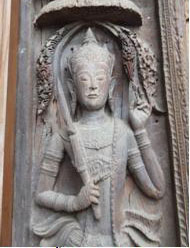
An artwork on the door frame at Phra Si Sun Petch in Ayutthaya province
Champak Flower in the Royal Siamese Court during the Rattanakosin Period
During the Rattanakosin period, evidence suggests that champak was widely used to convey auspicious meaning, and to signify that the owner was of a high rank. There are two type of usage;
1. As an accessory in important royal ceremonies.
The use of champak as an accessory in important royal ceremonies has been clearly documented since the early Rattanakosin period. It is believed that this tradition was inherited from the court of Ayutthaya. The ceremonies are in accordance to the Brahmin religion which were influenced by India. There is documentary evidence which mentions champak being used to decorate ceremonial accessories during the late Ayutthaya period. King Rama I commissioned a high-ranking official who was well versed in royal ceremonies to record details of the coronation of King Uthumphon for further reference and use in the Rattanakosin period. One part of the record says; Officers have built a mandapa next to Sanpetch Palace Hall to be used as a shower hall. There are decorations of naga in a downward and upward position and Bodhi leaves on the ceiling board. The ceiling is made up with white fabric, and was decorated with gold champak.
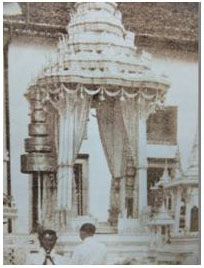
The ceiling of a shower hall for the coronation ceremony was decorated with gold champak.
The gold champak would be placed around the shower head of a shower hall for the coronation ceremony
This suggests that the use of gold champak in the coronation ceremony had existed even before the Rattanakosin period. It has also been used in the coronation ceremony of every King of Rattanakosin. The gold champak would be placed around the shower head. There is a document on the coronation of King Rama I, which states; The ceiling has been decorated with golden stars, tufts, a gold headpiece and golden champak. All four sides are linen with curtains, embroidered in traditional floral pattern.
The ceiling is made up with a decoration of champak for the preparation of the shower hall for coronation ceremony
Regarding the preparation of the shower hall for coronation ceremony in Rattanakosin period, the use of gold champak was mentioned as the following; The ceiling is made up with a piece of embroidered white cloth, gilt with gold. There is a decoration of champak festooned around the ceiling and also one hanging from the centre.
This type of use also appeared in the coronation ceremony of the present King in 1950. Gold champak flowers are made into bunches, resembling a festoon. It was also used to form a circle around the shower head in the shower hall for decorative purposes. A festoon made from gold champak was placed at the centre of the water outlet so that the water would flow through the festoon and because Champak is regarded as a sacred flower, the water that flowed through it became sacred as well. This clearly indicates an important use of champak in the coronation ceremony.
Furthermore, it has also been found that champak was used to decorate the main pavilion during a royal ceremony to worship the late Kings at Sanam Luang in 1932. This also indicates a relationship between gold champak decorations and royal ceremonies. Champak might be used to indicate the place where the king is seated or to help convey a kingly quality of the King.
2. As an accessory to regalia
The decoration of royal regalia using gold champak or gold champak festoons in the Rattanakosin period might have also been an inherited from the court of Ayutthaya as well. Golden champak flowers are seen on the brim of nine-tiered umbrellas which have been hung or placed over the King’s seat or in throne halls in the Royal Palace. The record of a royal shower ceremony during the reign of King Rama V mentions a use of champak festoons to decorate a seven-tiered umbrella during a shower ceremony for the occasion that Prince Vajirunhis received the Crown Prince’s title in 1886. The document says; The treasury was commissioned to bring 16 festoons of champak, in light and dark gold, and lotus bud shaped decorative pieces, with golden ruffles, to decorate the seven-tiered umbrella.
Also, during the current reign, it has been noted that gold champak flowers were used to decorate the brim of a seven-tiered umbrella placed on the top of the royal funeral pyre of significant royalties, for example, Princess Mother Srinagarindra. It can be assumed from this that gold champak was used on royal utensils during important royal ceremonies when royalties of high ranks are concerned. Champak flowers found on seven-tiered umbrellas, five-tiered umbrellas, and three-tiered umbrella, and some regalia which would be bestowed to a particular royal by the King.
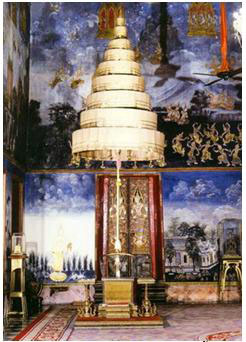
Golden champak flowers are seen on the brim of nine-tiered umbrellas which have been hung or placed over the King’s seat or in throne halls in the Royal Palace.
Champak flowers found on a seven-tiered umbrella
Champak flowers found on a five-tiered umbrella
Apart from being used as a decoration of the regalia in an umbrella’s category. Champak flowers have also been seen on the brim on five-tiered umbrellas placed above some Buddha figures or main Buddha figures which bear a particular relation to the King. For example, they can be found on the umbrella placed over Buddha Maha Chakra Pat - the main Buddha of Nang Nong Temple, which was cast by King Rama III. Another example is the umbrella over Budda Ankiros, the main Buddha of Wat Ratchabophit Sathit Maha Simaram Ratcha Wara Maha Wihan, which was cast in the late period of King Rama IV’s reign, by King Rama IV and King Rama V. It is likely that the decoration of champak is related to the fact that the Buddha figures had been cast by the Kings. Additionally, Champak decoration has also been found on umbrellas or regalia bestowed to the Supreme Patriarch and the royals who held this title.
It can be said that the Royal Court of Siam has had a tradition of decorating the lowermost tier or the brim of many-tiered umbrellas which are used as regalia, both by means of hanging or standing with champak flowers. This tradition also includes champak decorations on high regalia bestowed to some particular royals of high rank.
The fact that golden champak are used in a hanging manner on regalia, which are of a considerable height, or on the brim of the royal shower might imply that the belief related to the idea of flowers falling from heaven, or being showered down to the earth by deities on special occasions. Such belief made an appearance in art, for example, a painting of falling flowers, which resemble clusters of champak, on a screen in the main hall of Wat Ratchabophit Temple. This is also consistent with the high status and the great significance of champak. Flowers showering from heaven might convey a blessing to the King or the royalty who was presiding under the royal umbrella or the high regalia. Champak is thus considered an auspicious flower used solely within the Royal Court of Siam.

A painting of falling flowers on a screen in the main hall of Wat Ratchabophit Temple
Gold Champak and Silver Champak: Treasure in the Hall of Royal Regalia
The aforementioned use of Champak at the Royal Court of Siam as an accessory of royal umbrellas or in important royal ceremonies is consistent with the national records regarding a royal shower ceremony in the period of King Rama V. The record mentioned a withdrawal of champak festoons from the treasury for the purpose of decorating a seven-tiered umbrella. This not only clearly indicates the actual use of the champak, but also indicates the agency who was responsible for keeping the objects during that period, namely the treasury. The treasury is responsible for maintaining silver, gold, bronze bia coins, banknotes, regalia and gemstones, which are all a part of national property. Nowadays, these treasures mostly are under the care of the treasury department. The grand national treasure bureau has selected a number of significant and interesting pieces to be displayed at the pavilion of regalia, royal decorations and coins, where nearly a thousand items of rarely-seen treasures from the Siamese court are being exhibited. Gold champak and silver champak are among these selected items. They might have been used as accessories or a decorative pieces in the royal shower during the coronation ceremony. They might have also been used to decorate the seven-tiered umbrella to symbolise an act of worship. Champak is a flower of high rank according to Indian belief and decorative pieces of champak are crafted to signify such meaning. They are used in significant royal ceremonies or to decorate the seven-tiered umbrella in the King’s throne hall or over the King’s seat, which can still be seen today.
Champak flowers are made from gold or silver leaves. The leaves are cut into a long shape resembling champak petals. There are 12 petals in one champak flower, including 6 for the inner layer and another 6 for the outer layer. The petals which form the inner layer are smaller and more slender. The stalks of the flowers are made into 5 layers of sepals and are smaller than all the petals. There are 2 types of arrangement of champak, namely, stringing them into a festoon and attaching each onto a metal hoop. There are 3 groups of champak in the bureau’s possession:
1. A cluster of gold champak consisting of 32 champak flowers attached onto a metal hoop. It was used to decorate the shower outlet in the shower hall during the coronation ceremony.
A cluster of gold champak
2. There are 29 Gold champak flowers threaded into several strings and made into a festoon and used to decorate the eaves of the royal shower hall or at the nozzle.
Gold champak flowers
3. There are 22 silver champak flowers threaded into several strings and made into a festoon.
Silver champak flowers
The champak flowers which are being exhibited in the pavilion of regalia, royal decorations and coins reflect Thai wisdom in crafting valuable metals into the shape of a natural flower with great accuracy in order for them to be used as a decoration of a regalia or an accessory to royal ceremonies. This usage appears exclusively in the Royal Court of Siam. It also reflects a belief about an auspicious flower which has been carried on in the court for a very long time. Therefore, these items are a great example of national treasure which are both rich in meaning and in value. They are definitely worthy of being kept with high regard as a national treasure.
Translated from
Somsak Ritpakdee. (2014). Champak: From the Flower of the Court of Siam to a National Treasure. (Thai version) Retrieved September 14, 2014, from Pavilion of Regalia, Royal Decorations and Coins e-museum: http://emuseum.treasury.go.th
